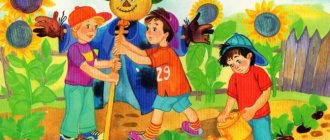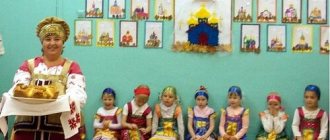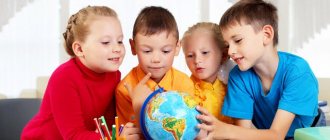Summer time is a wonderful time to relax and devote yourself and your child to creativity. You can make countless wonderful and easy-to-make projects from the most ordinary things: flowers, shells, river stones, ears of corn, leaves. No child or adult will remain indifferent.
Keeping your child busy with such pleasant little things is not only pleasant, but also useful, as it contributes to the development of his creative thinking, hand motor skills, and brings positive emotions.
For younger children
Crafts for children 3-4 years old seem like something magical to them. Children are proud of the work they have done and are happy to show it off to others. When choosing an idea, remember that children's motor skills are different from those of adults. Details should be large and simple. It is advisable to prepare the preparations in advance.
Children of primary preschool age should be creative. This contributes to the harmonious development of personality. Preschool educational institutions conduct weekly group classes. The task of parents is to reinforce these skills.
Crafts from plasticine
Children 3-4 years old do not know how the learning process works. There is no need to rush when working together. All movements must be slow and accompanied by a voice explanation.
Application “Summer lawn”.
Materials you will need:
- a sheet of green cardboard;
- plasticine 6-8 colors.
The goal is to create an interest in sculpting.
The lawn is a sheet of cardboard. We talk with the child that in the summer flowers grow in the meadow and the sun shines brightly. We show how to sculpt flowers, such as daisies, from plasticine. The middle can be made in a different color. We make a sun in the right corner.
Herbarium
Herbarium is probably one of the girls’ favorite activities. By preparing dried flowers in the summer, you can create interesting homemade products in the fall. Postcards, gift bags, bookmarks and even entire compositions can be created from ordinary dried flowers. Such crafts can easily decorate your apartment!
Summer crafts have always been distinguished by their brightness and originality. In winter, such homemade products help you return to summer, remember your vacation, the smell of summer flowers and the sound of the surf.
For middle group children
Children of middle preschool age pay attention to details. The creative process becomes more meaningful. Applications on the theme of summer are becoming more diverse. The child begins to fantasize and add details on his own. When setting a topic, use your imagination with your child.
From colored paper
At the age of 4-5 years, children own scissors. This skill needs to be encouraged. The development of motor skills is directly related to brain processes. A wonderful way to reinforce a skill is through joint creativity between a child and a parent.
Application "Hello Summer".
Materials:
- A sheet of colored cardboard for the background (blue, green, white);
- Colored paper;
- Glue;
- Scissors;
- Black felt-tip pen.
The goal is to consolidate the skill of working with colored paper and cutting.
- Cut a sheet of white paper in half. Fold half the sheet several times. It should look like a tube. This will be a birch trunk.
- Glue a paper birch trunk onto a sheet of cardboard. Draw strokes on the trunk with a black felt-tip pen that imitate the color of a birch trunk.
- Cut out leaves from a sheet of green paper. They can be of different shapes and sizes. Glue them around the top of the trunk.
- To create a landscape, you can cut out flowers, the sun, butterflies. They are also glued to a sheet of cardboard.
Application “Hello, summer!” from colored paper
Watch the video on how to make a simple summer application “Bee” from colored paper:
From cotton swabs
Cotton swabs are a wonderful material for creating compositions. In summer applications they can be conveniently used as flower petals.
Application "Daisies".
Materials:
- A sheet of colored cardboard for the background;
- Green colored paper;
- Cotton buds;
- Yellow plasticine;
- Glue.
The goal is the development of fine motor skills, the development of spatial thinking.
- Cut out stems and leaves of daisies from green colored paper. To do this, first draw an outline with a simple pencil on the back of a sheet of colored paper. Glue the resulting stems and leaves onto a sheet of cardboard.
- Roll the yellow plasticine into a ball, pressing it lightly. The yellow circles will be the centers of the daisies.
- Cut the cotton swabs in half with scissors. Stick the resulting “leaves” into yellow plasticine.
“Chamomile” applique made from cotton swabs
Don't rush your child. At this age, children pay great attention to the smallest details. It’s not surprising if the baby spends 20 minutes inserting cotton swabs into the plasticine.
Application made of cotton wool “White cat”.
For this application you will need: a sheet of thick blue paper, cotton wool, green paper, pieces of red and black paper, scissors, glue.
First, glue white cotton clouds to the blue background. To do this, draw them on the background with a simple pencil, smear the drawn areas with glue and put lumps of cotton wool there. Gently press down the cotton wool with your fingers, working especially well on the edges of the clouds. Let's let them dry.
Then draw the silhouette of a cat on a blue background with a simple pencil.
Cut a strip of green paper. Let's make cuts on one side and glue a strip at the bottom of the background. This will be our green grass.
Let's prepare a ball of cotton wool and place it along the silhouette of the cat. Let's try it on. Then we will remove the cotton wool. Lubricate the silhouette of the cat generously with glue and glue the cotton wool to the background in the drawn place, giving it the shape of a cat. Press the cotton wool onto the background with your fingers.
When the application dries, you can fluff the cotton wool a little with your fingers to make the cat seem fluffier.
All that remains is to glue the paper cat’s eyes (it’s better to make them green), a mustache and a red mouth. The application is ready. The cat turned out to be flirty and graceful.
Applications for children of senior and preparatory groups
Children 6-7 years old master all creative techniques. At this age, they are able to independently come up with and implement a composition. The Hello Summer application will not cause any difficulties for children.
From cardboard
Application on the theme of summer made of cardboard has many variations. Trust your child to choose what he will do. Believe me, the work will turn out wonderful.
Application "My yard".
Materials:
- colored cardboard;
- scissors;
- glue.
The goal is to develop fine motor skills and develop imagination.
Children of the preparatory group feel like adults. Give the children a theme for playing in the yard. Ask them to make a composition from colored paper or cardboard of the yard in which they live or the area in the kindergarten.
Each yard has a slide, swings, carousels, a sandbox, and trees. Making them from colored paper or cardboard is not difficult. Every child will be able to show their imagination and create a beautiful composition.
Watch the video on how to create a voluminous summer paper applique:
From cereals
Bulk material is loved by all children. A kindergartener will do this type of creativity with pleasure.
Application “At the Sea”.
Materials:
- a sheet of white cardboard;
- semolina;
- millet;
- buckwheat;
- glue.
The goal is to develop three-dimensional thinking.
- Take a sheet of cardboard and cover it completely with glue.
- Sprinkle with semolina - this is the beach.
- At the top of the sheet, use glue to draw the sun and sprinkle with millet. Shake off the remains.
- At the bottom of the sheet, similarly, using glue, draw shells and sprinkle with buckwheat. Carefully remove any remaining residue. The work must dry thoroughly.
Application “Sea” from cereals
Face: identification and placement of sensory organs
The head model is a whole map on which the eyes, mouth, ears, etc. are located. To conduct a fascinating lesson on studying the senses and their locations, prepare a “platform” in advance. Attach the face to a cardboard sheet and make blanks of all the necessary elements, which the baby will have to glue himself in the appropriate places.
Sequencing:
- It’s worth starting with the eyes, which will become a guide for placing other positions.
- Then comes the turn of the nose, lips, eyebrows and ears.
- Make hair from ribbons or threads if you want to make the craft voluminous and more impressive.
To simplify the process of creating blanks, we offer you the following stencils. Simply print them out and cut out the parts you need.
For children 1-2 grades
An application on the theme of summer in grades 1-2 is a favorite task for teachers. You can also practice at home. Children at this age can make their own applique. The adult’s task is to teach new techniques.
From napkins
This technique requires patience and perseverance. This is an ideal option for schoolchildren.
Application “Summer meadow”.
Materials:
- Sheet of cardboard;
- Napkins of different colors;
- Glue.
The goal is to develop attention and perseverance.
- Prepare the material for the applique - roll small balls of different colors from napkins.
- On the background, draw a diagram of the arrangement of elements with glue. It can be anything: flowers, rainbows, sun, trees, mushrooms.
- Then lay out the prepared small balls. You will get an interesting three-dimensional picture.
Application “Summer meadow” from napkins
To the competition
Children try to make beautiful and original crafts that will be presented at the competition.
First you need to decide on the topic:
- "Fire in the Forest";
- "Children and Fire";
- “Fire is our enemy and friend” and so on.
At the second stage, kids make crafts. For example: a model of a helicopter for extinguishing fires, a fire truck made of buttons, or an original volumetric exhibition.
For kindergarten
For the middle group
For the older group
For schoolchildren
Pupils in grades 3–4 make complex applications. Children can already sew a figurine of a rescuer and dress him up in firefighter clothes. Boys build large fire trucks, helicopters and other equipment from matches.
Internal organs
To familiarize yourself with internal anatomy, we recommend taking several informative lessons. It will be easier for the baby to fold by referring to schematic drawings of this kind.
Repeat the name of each organ out loud to learn how to pronounce it correctly and remember it faster. For initial preparation, a simple paper creation and printed blanks are suitable.
Remember that it is worth distinguishing between ages, so start studying with preschoolers. For convenience and to speed up the preparation process, organ templates can be made from plasticine and laid out on an image of the body, which is used as the basis for the craft.
When your baby gets comfortable with the basics, make the task more difficult:
- From cardboard or thick felt of different colors, cut out the body, organs and main skeleton.
- Stock up on adhesive tape. Cut it into small squares. Glue or sew pieces of the lower part in certain areas on the body, and pieces of the upper part - on organs and bones.
The result will be a kind of educational game.
A multi-layer product is a fascinating and educational thing with a reusable function. The elements involved in it are attached with Velcro, which is very convenient. We hope that our lessons were useful to you.
Man in motion: the basics of creating an application
Many parents find it very difficult to depict dynamics or movement in static appliqué, especially for young children. The technique of geometric appliqué will help you cope with this task, helping you to study the structure of the body and convey dynamics, and become familiar with the names of different poses:
- to create human figures in a certain pose, standard blanks from geometric shapes are used;
- arms and legs (from double thin strips), a wide strip for the body, a square for the head, it is better to prepare in advance;
- the best option would be to use checkered notebook sheets, which will help you make a lot of blanks;
- on a white paper base it is easy to depict little people in different poses, while at the same time voicing them to the child in sound form.
This technique is used to create full-fledged applications of playing people, studying the structure of the body, which can perform various actions familiar to the child. During the lesson, you can make a picture depicting figures playing football, doing exercises and picking flowers, raising their hands or swimming in the water.





